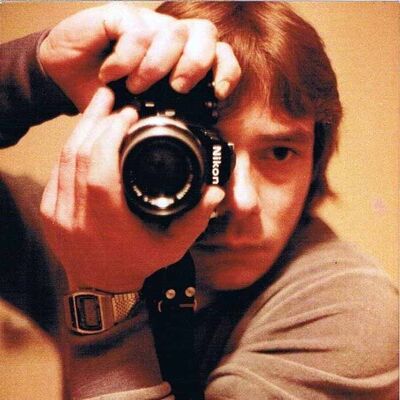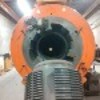Image quality of 35mm slides vs. digital photos
May 15, 2014 10:58:01 #
mikedent
Loc: Florida
Last night we looked at a bunch of 35mm slides I did 20-30 years or more ago using an old slide projector. I was totally amazed at the clarity, colors, sharpness,and intense details I could see compared to what I've seen on digital images on computer screen. Back then I used Olympus OM2N, Tokina 28-85 lens, Fuji 100 slide film. Now I've got all Nikon equipment using highest quality JPEG. OK, not RAW files or pp, but still. Is this a common finding? Maybe due to larger 35mm sensor, analog exposures? Poor computer screen resolutions? Would a modern digital projector give a better result? Differences in projection screens? It was kind of disappointing really. Just had to vent.
May 15, 2014 11:23:49 #
The one problem with digital photography is that it can't record all the nuances of color that good old fashioned film properly processed can. Digital is getting better but, it ain't there yet. In addition, the resolution of your monitor is probably not as good as the slide even though it projected.
May 15, 2014 11:41:35 #
May 15, 2014 11:47:05 #
GrayPlayer
Loc: Granby, Ct.
An age old question I am not qualified to answer BUT, for my money film grain for Kodacolor or Kodachrome (incidentally, spell checker recognized neither word) is much finer than pixels, at least in their present state.
May 15, 2014 11:54:26 #
Also, you are viewing slides with intense light projected directly through the high resolution image itself. It is a more direct process with more intense light, which more closely mimics the light our eyes see all around us. If you could do an A B C test ie, a monitor view, a slide view and a window view outside, it would be more apparent. Viewing slides directly on a light table or a direct view optical slide viewer, rather then from a projection reflected off a surface such as a wall or screen, become even more "real" to the point of having 3D qualities.
May 15, 2014 12:01:54 #
amehta
Loc: Boston
mikedent wrote:
Last night we looked at a bunch of 35mm slides I d... (show quote)
I don't think this is an apples to apples comparison of projection methods, which may be a big factor in the difference.
May 16, 2014 02:01:41 #
Yes, I found slides from 120 film on a mamiya film camera to have more vibrant and natural colors, better gradations of light across the image, and better detail than I got from my Nikon D3100, even using the same Mamiya lenses with an adapter on my Nikon, and cropping the scanned film images to get the same crop as on the dslr. The problem with shooting film is the cost per image (about $1.65 per image for film, processing and postage), the waiting for processing, the difficulty of getting really good clean scanned images (I do it myself), and the need to post process the scans to remove dust and lint which shows up on the scans regardless of how careful I am. If I was trying to get a cash prize for my best shot, I'd shoot film. But since no one really cares what I shoot except me, I do the best I can with digital.
May 16, 2014 09:06:36 #
I still see nothing to compare with 4x5 bw sheet film shot in a Speed Graphic.
May 16, 2014 09:30:14 #
rps wrote:
I still see nothing to compare with 4x5 bw sheet film shot in a Speed Graphic.
That's not really a fair comparison. An 8x10 Linhof film shot will be "cleaner" than the 4x5. 35mm is 1x 1.5 inches. So a 4x5 is comparing a 20 sq inch negative to a 1.5 sq inch negative. That being said most people don't produce wall size prints any way so the noise in an 8x10 inch print, really isn't visable regardless of the format.
May 16, 2014 09:30:15 #
Yes, really good film is still better. BUT, you were not comparing fairly to your digital pictures. The digital pictures I take are 6,000 by 4,000 pixels. A good monitor is for instance 1280x1024 pixels. A digital projector is no better and probably worse. Each pixel on the screen is representing the average of 5x4=20 pixels from your digital photo. You are only seeing 1/20 of what's in your digital photo. Zoom in to 100% full resolution and you'll see what is really in your digital photo.
May 16, 2014 10:25:35 #
Mark7829
Loc: Calfornia
That is an unfair comparison. I have produced some fantastic slides but then you print, it does not compare with the projector's ultra-bright rendering which can hide imperfections and noise.
I think you are tying to make the argument that others have tried to make - film is better. Comparing traditional 35 mm film/slides with today's full frame cameras, there is no comparison. And please do not compare 35 mm with 4x5 or much larger format film cameras under controlled conditions and post processing. These are unique situations that only on special situations renders comparable output to days DSLRs.
The control we have in today's full-frame cameras are remarkable if not a miracle of technology. Enjoy your old slides but there is no argument here. The digital age is superior to the old processes for the supposes we shoot. Does anyone want to go back?
I think you are tying to make the argument that others have tried to make - film is better. Comparing traditional 35 mm film/slides with today's full frame cameras, there is no comparison. And please do not compare 35 mm with 4x5 or much larger format film cameras under controlled conditions and post processing. These are unique situations that only on special situations renders comparable output to days DSLRs.
The control we have in today's full-frame cameras are remarkable if not a miracle of technology. Enjoy your old slides but there is no argument here. The digital age is superior to the old processes for the supposes we shoot. Does anyone want to go back?
May 16, 2014 11:13:52 #
The negative (whether 4x5 or 8x10) is only a means to the end. The print is the end product. Some of those old routine 8x10 glossies from 4x5 negatives often are nothing more significant than a news photo or a head-table group but still are technically superb images.
But digital is so much easier and quicker that we make some concessions. I, for one, don't want to go back to chasing dust, working by feel in the dark or a changing bag, mixing chemicals, keeping temperatures at 68F, doing test strips,
washing prints, ferrotyping them, spotting them etc etc.
But digital is so much easier and quicker that we make some concessions. I, for one, don't want to go back to chasing dust, working by feel in the dark or a changing bag, mixing chemicals, keeping temperatures at 68F, doing test strips,
washing prints, ferrotyping them, spotting them etc etc.
May 16, 2014 15:04:04 #
rps wrote:
I still see nothing to compare with 4x5 bw sheet film shot in a Speed Graphic.
Except maybe an 8x10 view camera, I'm still looking for one.
I shot 4x5 color transparencies years ago and just looking at the film on a lightbox I thought I was there.
May 17, 2014 02:33:04 #
Michael O'
Loc: Midwest right now
mikedent wrote:
Last night we looked at a bunch of 35mm slides I d... (show quote)
Mikedent, what you have seen is what we get. Digital is so crisp that it unable to portray the richness of color of film. There is no getting around it. This is quite analogous to the difference in sound between the old tube-type pre-amps and amps, which produced a richness of sound that is just not achievable with the crisp (comparably it is a harshness) sound
emitted by the solid state amps and pre-amps. Crystal clear, and harshly "thin." Perfect, but with the loss of that full richness
of the tube-type sound reproducers -- that sound more like you were actually listening to the original creation of the music,
be it piano, full orchestra, jazz group, or whatever. The subtle but noticeable difference is always there.
Similarly, the digital reproduction is so harshly pure that it cannot have the richness of color film. So we have lost, while we have gained.
May 17, 2014 04:12:12 #
for all practical purposes that slide is a full frame RAW image at a higher resolution than any but a few very expensive cameras can approach (think NASA and spy plane cameras). The hitch with film is that it had to be processed exactly right. I will assume those slides were done by the same people who made the film, they were done right. You will also remember that some film came in ASA 32 and ASA 50, most cameras don't do those speeds today, they start at 100 which I remember was thought of as high speed grainy film in the 60's and 70's. Also, the film was probably above 24bit in the number of colors it could portray, at least the good stuff, processed right. Then the monitor or projector gets it's chance to down grade the image.
If you want to reply, then register here. Registration is free and your account is created instantly, so you can post right away.






